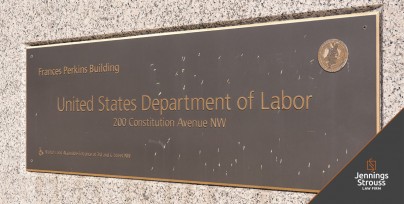The U.S. Department of Labor Provides Added Guidance for Application of the Emergency Family and Medical Leave Expansion Act and the Emergency Paid Sick Leave Act
March 24, 2020

Chris M. Mason
Jennings,Strouss & Salmon, P.L.C. - Labor and Employment Blog
Phoenix, AZ
On March 24, 2020, the U.S. Department of Labor (DOL) published its initial Guidance providing helpful explanatory information and some much needed clarification of certain terms and requirements of the Emergency Family and Medical Leave Expansion Act (FMLA Expansion Act) and the Emergency Paid Sick Leave Act (Paid Sick Leave Act) (jointly, the Acts). The DOL News Release with additional links to Fact Sheets and Q&A Document can be found below:
https://www.dol.gov/newsroom/releases/whd/whd20200324
We expect formal regulations and additional guidance in the near future. A few of the key insights from the DOL are identified below:
The Effective Date and Problem with Early Provision of Paid Leave
The FMLA Expansion Act and Paid Sick Leave Act will become effective April 1, 2020, so employers need to be prepared to implement their policies with respect to these leave rights by then. While the Acts were signed into law on March 18, and had a 15-day delay until effective, the DOL Guidance clarifies that employers are expected to begin providing leave when requested starting April 1.
Employers that provide paid leave early, namely before April 1, will not be relieved of the full obligation to provide additional leave effective April 1. The DOL made clear in its Guidance that the paid leave provisions in the FMLA Expansion Act and the Paid Sick Leave Act start afresh on April 1.
Employee Headcount for the 500-Employee Cutoff
For purposes of determining whether an employer has fewer than 500 employees for application of the Acts, the DOL indicated that employers should count
“full-time and part-time employees within the United States, which includes any State of the United States, the District of Columbia, or any Territory or possession of the United States. In making this determination, [employers] should include employees on leave; temporary employees who are jointly employed by you and another employer . . .; and day laborers supplied by a temporary agency. . . . Workers who are independent contractors under the Fair Labor Standards Act (FLSA), rather than employees are not considered employees for purposes of the 500-employee threshold.”
The number of employees for purposes of determining application of the Acts should be made “at the time [the] employee’s leave is taken.” In other words, for those employers that are wavering around the 500-employee threshold, they should be regularly aware of the size of their workforce and any workforce changes on a daily basis when employees request leave that would qualify as paid leave under the Acts.
As anticipated, the Integrated Employer test under the FMLA will be used to determine whether the employees of two or more related entities should be counted together. The Integrated Employer test is a 4-criteria test for which there are existing regulations and a well-established body of case law that should be consulted and reviewed for guidance.
Small Employer Exemption Uncertainty Remains
Smaller employees with fewer than 50 employees must still await regulations from the Department of Labor, which hopefully will be forthcoming later this week. In the meantime, they should document why they believe that compliance with the Acts would jeopardize the viability of their businesses. And the Department made clear that employers “should not send materials to the Department of Labor when seeking a small business exemption for paid sick leave and expanded family and medical leave.”
If you have questions about this new rule, please contact Chris M. Mason, or any other attorney in our Labor and Employment practice.
ABOUT THE AUTHOR

Chris M. Mason | Read Bio


